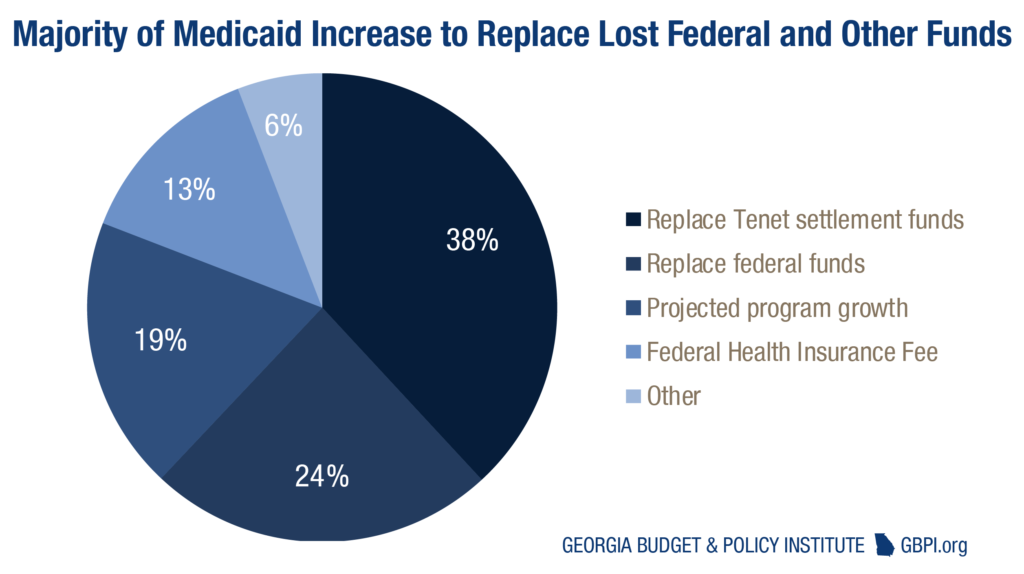Gov. Nathan Deal proposes a 2019 budget of $2.79 billion in state general funds for the Department of Community Health. This is an increase of $249.2 million from the 2018 fiscal year, mostly to replace non-recurring court settlement funds in last year’s budget and to offset a decrease in the federal matching rate for Medicaid. Federal funding for the department is $7.8 billion in the 2019 fiscal year that begins July 1, 2018. The proposed state budget also allots a total of $609.3 million from a tobacco industry legal settlement, nursing home provider fees and hospital provider fees. The budget includes another $3.65 billion from the State Health Benefit Plan Division, which manages health insurance coverage for state employees, retirees and their dependents.
The amended 2018 budget proposes adding $50 million in state general funds, including:
- $20.6 million for Medicaid baseline expense growth. Projected Medicaid spending for the elderly, blind and people with disabilities is increased by $26.9 million and Medicaid spending for low-income residents is reduced by $6.3 million.
- $23 million to fund the state match for federal disproportionate share hospital payments for private hospitals
- $1 million in state general funds matched with $8.2 million in federal funds for the implementation of an electronic visit verification system for home and community-based services. All Medicaid state agencies are required to implement this system under the 21st Century Cures Act passed by Congress in 2016. States receive a higher federal match to support the system designed to improve tracking of care service visits and reduce gaps in care.
One in Five Georgians Get Health Coverage through Medicaid and PeachCare
The majority of the department’s budget is spent on Medicaid and PeachCare. These two programs provide more than 2 million Georgians with the ability to see a doctor. Ninety-seven percent of state funds and 92 percent of federal funds in the proposed 2019 department budget are allocated to Medicaid and PeachCare.
The governor’s proposed 2019 budget includes adjustments for projected expenditure growth, nursing home rate increases and the reinstated federal health insurer tax. Compared to last year’s budget, these changes include:
- $92.3 million to replace one-time funds from Tenet Healthcare’s 2016 settlement of federal fraud charges. The state used that money in the 2018 budget to comply with federal Hepatitis C treatment access requirements, expand autism coverage and behavioral health services for children, increase primary care reimbursement rates and account for enrollment growth and rising Medicare costs.
- $57.9 million to offset the decrease of the federal medical assistance percentage (FMAP) from 68.5 percent to 67.62 percent for the federal 2019 fiscal year.
- $45.7 million in state general funds and $96.4 million in federal funds for projected growth in Medicaid spending based on need.
- $32.2 million in state general funds and $68 million in federal funds for the Health Insurance Tax created under the Affordable Care Act of 2010. This tax helped pay for the health insurance marketplaces until it was suspended in 2017. It is scheduled to take effect again in 2018, subject to congressional action. Costs to the state will increase as Medicaid managed care plans raise their costs to account for the reinstated tax.
- $16.9 million in state general funds and $35.6 million in federal funds for a 4.3 percent increase in nursing home reimbursement rates.
- $3.4 million in state general funds and $7.1 million in federal funds for a $12.62 increase in reimbursement rates for alternative living service providers as part of the Community Care Services Program. The program provides medically fragile older adults with services to help them remain in their homes and communities.
2019 Budget Directs More Spending Toward Medicaid
The 2019 proposed budget includes $242.3 million in state general funds for Medicaid and PeachCare for Kids. Sixty-two percent of that is to replace Tenet settlement funds and federal funds no longer available for 2019. Georgia’s federal medical assistance percentage is set to decline by .88 percentage points in federal 2019 fiscal year, which starts on Oct. 1, 2018. The percentage adjusts each year based a state’s average per capita income relative to the national average. Georgia’s increase in per capita income caused the decline in the matching rate.

Projected spending growth of about 1.7 percent accounts for one-fifth of the increased spending on Medicaid and PeachCare. This is normal growth in light of the state’s 1.1 percent population increase each year since 2015.[1] Because medical inflation tends to be higher than general inflation, the rise in health care spending also contributes to increased growth. As the state considers options to address Medicaid spending growth, it is important to look beyond enrollment increases. Restricting enrollment does not address the major cost factors, such as rising drug prices and high rates of chronic disease. Maintaining consistent coverage increases the likelihood for people to receive preventive health services and seek necessary care before their conditions deteriorate and become more expensive to treat.
2019 Budget Does Not Help More Georgians Get a Health Insurance Card
About 460,000 Georgians could be eligible for affordable health coverage if Georgia expanded Medicaid income eligibility.[2] Georgia is one of 18 states that have not expanded Medicaid under the Affordable Care Act to receive new federal money to cover more low-income residents. The state’s uninsured rate remains high and hundreds of thousands of working poor Georgians do not have health coverage options through their employer or the health insurance marketplace.
Georgia’s health care system can also benefit from expanding coverage. Medicaid expansion aims to reduce uncompensated care by decreasing the uninsured population. As a result, the law scheduled a decline in federal disproportionate share hospital payments to hospitals who serve a large number of uninsured patients. The decline is set to start this year if Congress does not delay the cuts. Rural and safety-net hospitals in Georgia and other states that did not take federal dollars to expand Medicaid stand to suffer the most. Georgia lawmakers need to act urgently to accept the strong return on investment by allowing the state to receive about $9 in federal money for each dollar the state spends. Leveraging this federal money can extend coverage and give rural hospitals a boost.
State Health Benefit Plan and Other Department Programs
The department also oversees the State Health Benefit Plan, the Indigent Trust Fund, the Dentistry and Pharmacy Boards, Health Care Access and Improvement, Healthcare Facility Regulation, and administration.
State Health Benefit Plan
The State Health Benefit Plan offers health insurance to Georgia’s active and retired state employees, teachers and other public school employees. About 650,000 Georgians receive health coverage through this plan. The program is paid for through employee and employer contributions.
The 2019 budget estimates the plan will spend $3.65 billion, an increase of $211.3 million from the 2018 budget. The majority of this 6.1 percent increase is $263.6 million to reflect changes in membership and use since the last projection. Some of this is offset by other changes, including:
- $72.1 million in procurement savings for Medicare Advantage plans, Health Maintenance Organization plans and a pharmacy benefit manager in plan year 2018.
- $2.2 million increase to reflect enrollment growth to match Medicaid age requirements for autism treatment that took effect Jan. 1, 2018. This requirement increased autism benefits for people from ages six to 21.
- $12.1 million increase for a 3.7 percent average rise in non-Medicare Advantage employee premiums, effective Jan. 1, 2018.
- $5.5 million increase for a $20.57 premium rise for Medicare Advantage plan members, which took effect Jan. 1, 2018.
Departmental Administration and Attached Agencies
The remaining six department programs are set to receive a combined $96.7 million in state general funds, a $5 million increase from 2018. The budget also proposes $610.2 million in federal money, a nearly $20 million increase from last year. Most of the state increase is to fund quality assurance and program monitoring staff, as well as design and implement health information technology initiatives. One of these initiatives is an enterprise data solution to replace the state’s over 15-year old federally required database of Medicaid and State Health Benefit plan data.
The $399.6 million in the Indigent Care Trust Fund is the same as the 2018 budget signed by the governor last spring. The amended 2018 proposal increases the fund by $23 million using state general funds. This new money would be used to provide the state match for federal disproportionate share hospital payments for private hospitals. The Indigent Care Trust Fund is used to support rural and other health care providers that serve people who do not have health insurance and are not eligible for other health coverage.
The department budget also contains administratively attached agencies, including the Georgia Board for Physician Workforce, Georgia Composite Medical Board, and Georgia Drug and Narcotics Agency. Spending for these agencies totals $73.5 million, an increase of $1.9 million from 2018.
New in the proposed budget is $1.9 million to add 122 residency slots in primary care medicine. Georgia produces more medical school graduates than the state has residency slots, making it difficult for the state to retain health care workers to practice in Georgia.[3] The state added 126 primary care medicine slots in last year’s budget and the addition of more slots this year will continue to help strengthen the state’s health care workforce.
Endnotes
[1] U.S. Census Bureau. Annual Estimates of the Resident Population: April 1, 2010 to July 1, 2017.
[2] Garfield R and Damico A. “The Coverage Gap: Uninsured Poor Adults in States that Do Not Expand Medicaid.” Kaiser Family Foundation. November 2017.
[3] Georgia Budget and Policy Institute (2016). “Prescribing Remedies for Georgia’s Medical Provider Shortage.”



